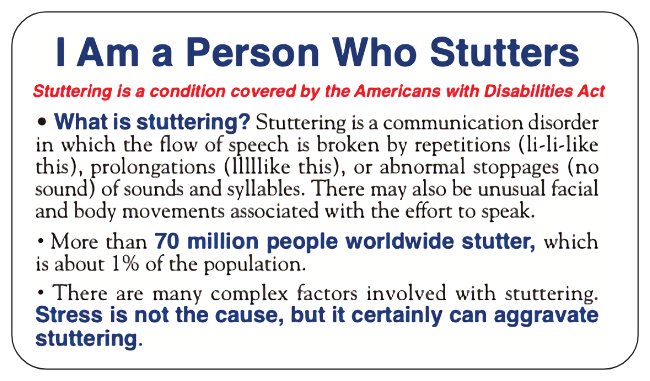
About
According to the National Institute on Deafness and Other Communication Disorders, “An estimated 17.9 million U.S. adults ages 18 or older, or 7.6%, report having had a problem with their voice in the past 12 months.” There are various types of speech disabilities which cause disfluencies such as Stuttering, Apraxia, Dysarthria and other speech sound disorders.
General recommendations
-
Be patient. It is tempting to try to complete sentences for people with speech disorders and/or involuntarily interrupt them between words. Try to be patient and avoid filling in words for them unless they explicitly tell you to do so. Refrain from giving advice such as ‘Relax’ or ‘Take deep breaths’ as not all speech disorders are caused due to being nervous or stressed. Even if they are, such simplistic advice may feel humiliating to the person with the speech disability.
-
Maintain eye contact. This helps reassure the person with a speech disorder that you are listening to what they have to say. Maintain eye contact unless they explicitly tell you not to.
-
Be mindful not to judge. It is easy to judge someone with a speech disorder as not being knowledgeable enough. Avoid having this misconception and focus on what they are saying instead of how they say it.
Additional recommendations for online meetings
-
Be open to them typing. People with speech disorders may prefer using typing or a combination of type/speech during online meetings. Make sure to use a platform that provides typing functionality and not just speech-based communication.
-
Keep an eye out on the chat. In addition to using a meeting platform with typing functionality, make sure to keep an eye out on the chat! Ask the person with the speech disorder if they would like a designated person to relay the message in chat via speech to others.
-
Be okay with the camera off. Some people with speech disorders may not prefer turning the camera on, even during 1:1 meetings. Respect their decision.
Additional resources and references
-
Quick Statistics About Voice, Speech, Language | NIDCD (nih.gov)
-
Speech Disabilities | Web Accessibility Basic Concepts - Wells Fargo (dequeuniversity.com)